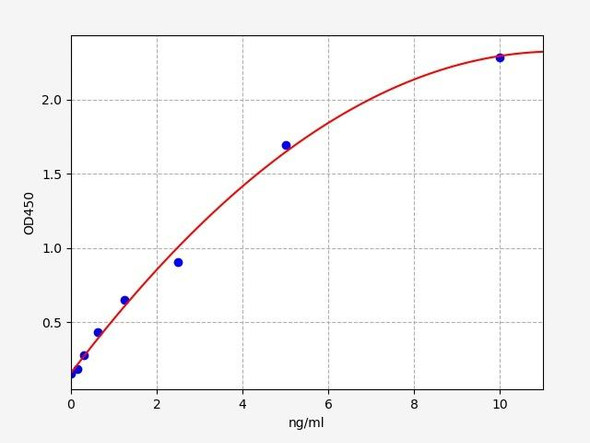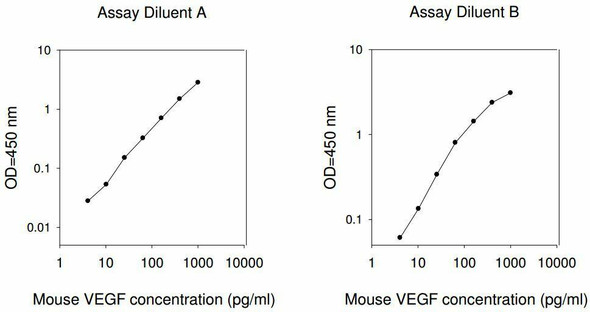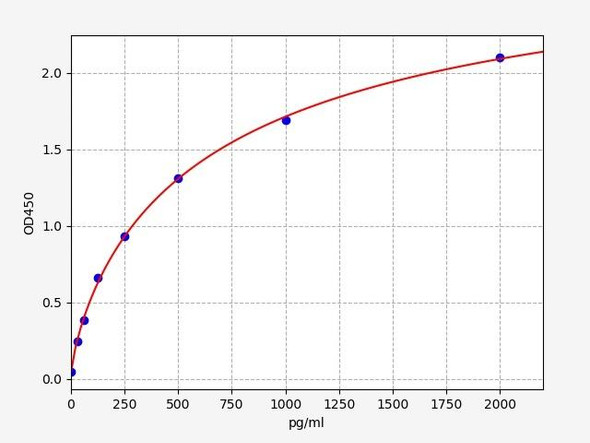Mouse Cardiovascular ELISA Kits
Mouse VEGF ELISA Kit
- SKU:
- MOFI00111
- Product Type:
- ELISA Kit
- Size:
- 96 Assays
- Uniprot:
- Q00731
- Sensitivity:
- 9.375pg/ml
- Range:
- 15.625-1000pg/ml
- ELISA Type:
- Sandwich
- Synonyms:
- VEGF, Vascular Endothelial Cell Growth Factor, VAS, Vasculotropin, VEGFA, VPF, MVCD1, vascular endothelial growth factor A, Vascular permeability factor, VEGF-A
- Reactivity:
- Mouse
- Research Area:
- Cardiovascular
Description
| Product Name: | Mouse VEGF ELISA Kit |
| Product Code: | MOFI00111 |
| Size: | 96 Assays |
| Alias: | VEGF, Vascular Endothelial Cell Growth Factor, VAS, Vasculotropin, VEGFA, VPF, MVCD1, vascular endothelial growth factor A, Vascular permeability factor, VEGF-A |
| Detection Method: | Sandwich ELISA |
| Application: | This immunoassay kit allows for the in vitro quantitative determination of Mouse VEGF concentrations in serum plasma and other biological fluids. |
| Sensitivity: | 9.375pg/ml |
| Range: | 15.625-1000pg/ml |
| Storage: | 4°C for 6 months |
| Note: | For Research Use Only |
| Recovery: | Matrices listed below were spiked with certain level of Mouse VEGF and the recovery rates were calculated by comparing the measured value to the expected amount of Mouse VEGF in samples. | ||||||||||||||||
| |||||||||||||||||
| Linearity: | The linearity of the kit was assayed by testing samples spiked with appropriate concentration of Mouse VEGF and their serial dilutions. The results were demonstrated by the percentage of calculated concentration to the expected. | ||||||||||||||||
| |||||||||||||||||
| Intra Assay: | CV <8% | ||||||||||||||||
| Inter Assay: | CV <10% |
| Component | Quantity | Storage |
| ELISA Microplate (Dismountable) | 8×12 strips | 4°C for 6 months |
| Lyophilized Standard | 2 | 4°C/-20°C |
| Sample/Standard Dilution Buffer | 20ml | 4°C |
| Biotin-labeled Antibody(Concentrated) | 120ul | 4°C (Protect from light) |
| Antibody Dilution Buffer | 10ml | 4°C |
| HRP-Streptavidin Conjugate(SABC) | 120ul | 4°C (Protect from light) |
| SABC Dilution Buffer | 10ml | 4°C |
| TMB Substrate | 10ml | 4°C (Protect from light) |
| Stop Solution | 10ml | 4°C |
| Wash Buffer(25X) | 30ml | 4°C |
| Plate Sealer | 5 | - |
Other materials and equipment required:
- Microplate reader with 450 nm wavelength filter
- Multichannel Pipette, Pipette, microcentrifuge tubes and disposable pipette tips
- Incubator
- Deionized or distilled water
- Absorbent paper
- Buffer resevoir
| Uniprot | Q00731 |
| UniProt Protein Function: | VEGF: Growth factor active in angiogenesis, vasculogenesis and endothelial cell growth. Induces endothelial cell proliferation, promotes cell migration, inhibits apoptosis and induces permeabilization of blood vessels. Binds to the FLT1/VEGFR1 and KDR/VEGFR2 receptors, heparan sulfate and heparin. NRP1/Neuropilin-1 binds isoforms VEGF-165 and VEGF-145. Isoform VEGF165B binds to KDR but does not activate downstream signaling pathways, does not activate angiogenesis and inhibits tumor growth. Defects in VEGFA are a cause of susceptibility to microvascular complications of diabetes type 1 (MVCD1). These are pathological conditions that develop in numerous tissues and organs as a consequence of diabetes mellitus. They include diabetic retinopathy, diabetic nephropathy leading to end-stage renal disease, and diabetic neuropathy. Diabetic retinopathy remains the major cause of new-onset blindness among diabetic adults. It is characterized by vascular permeability and increased tissue ischemia and angiogenesis. Belongs to the PDGF/VEGF growth factor family. 13 isoforms of the human protein are produced by alternative promoter. |
| UniProt Protein Details: | Protein type:Secreted; Secreted, signal peptide; Motility/polarity/chemotaxis; Cytokine Cellular Component: basement membrane; cell surface; cytoplasm; extracellular region; extracellular space; membrane; nucleus; plasma membrane; secretory granule Molecular Function:chemoattractant activity; cytokine activity; extracellular matrix binding; fibronectin binding; growth factor activity; growth factor binding; heparin binding; identical protein binding; platelet-derived growth factor receptor binding; protein binding; protein heterodimerization activity; protein homodimerization activity; receptor agonist activity; receptor binding; vascular endothelial growth factor receptor 1 binding; vascular endothelial growth factor receptor 2 binding; vascular endothelial growth factor receptor binding Biological Process: activation of CREB transcription factor; activation of protein kinase activity; alveolus development; angiogenesis; artery morphogenesis; basophil chemotaxis; blood vessel development; blood vessel endothelial cell proliferation during sprouting angiogenesis; blood vessel morphogenesis; blood vessel remodeling; branching morphogenesis of a tube; camera-type eye morphogenesis; cardiac muscle fiber development; cell differentiation; cell maturation; cell migration; cell migration during sprouting angiogenesis; cell proliferation; endothelial cell migration; epithelial cell differentiation; eye photoreceptor cell development; growth; heart morphogenesis; homeostasis of number of cells within a tissue; in utero embryonic development; induction of positive chemotaxis; kidney development; lactation; lumen formation; lung development; lymphangiogenesis; macrophage differentiation; mesoderm development; monocyte differentiation; mRNA stabilization; multicellular organismal development; negative regulation of apoptosis; negative regulation of bone resorption; negative regulation of caspase activity; negative regulation of cell-cell adhesion; negative regulation of fat cell differentiation; negative regulation of neuron apoptosis; negative regulation of programmed cell death; negative regulation of transcription from RNA polymerase II promoter; nervous system development; neuron development; ovarian follicle development; patterning of blood vessels; positive chemotaxis; positive regulation of angiogenesis; positive regulation of axon extension involved in axon guidance; positive regulation of blood vessel endothelial cell migration; positive regulation of cell adhesion; positive regulation of cell division; positive regulation of cell migration; positive regulation of cell motility; positive regulation of cell proliferation; positive regulation of endothelial cell proliferation; positive regulation of epithelial cell proliferation; positive regulation of focal adhesion formation; positive regulation of MAP kinase activity; positive regulation of mesenchymal cell proliferation; positive regulation of neuroblast proliferation; positive regulation of osteoblast differentiation; positive regulation of peptidyl-serine phosphorylation; positive regulation of peptidyl-tyrosine phosphorylation; positive regulation of positive chemotaxis; positive regulation of protein amino acid autophosphorylation; positive regulation of protein amino acid phosphorylation; positive regulation of protein complex assembly; positive regulation of protein kinase B signaling cascade; positive regulation of receptor internalization; positive regulation of signal transduction; positive regulation of smooth muscle cell proliferation; positive regulation of transcription from RNA polymerase II promoter; positive regulation of vascular endothelial growth factor receptor signaling pathway; positive regulation of vascular permeability; post-embryonic camera-type eye development; regulation of cell shape; regulation of cGMP metabolic process; regulation of endothelial cell differentiation; regulation of transcription from RNA polymerase II promoter; response to hypoxia; sprouting angiogenesis; surfactant homeostasis; T-helper 1 type immune response; vascular endothelial growth factor receptor signaling pathway; vasculature development |
| NCBI Summary: | This gene is a member of the PDGF/VEGF growth factor family. It encodes a heparin-binding protein, which exists as a disulfide-linked homodimer. This growth factor induces proliferation and migration of vascular endothelial cells, and is essential for both physiological and pathological angiogenesis. Disruption of this gene in mice resulted in abnormal embryonic blood vessel formation. This gene is upregulated in many known tumors and its expression is correlated with tumor stage and progression. Alternatively spliced transcript variants encoding different isoforms have been found for this gene. There is also evidence for alternative translation initiation from upstream non-AUG (CUG) codons resulting in additional isoforms. A recent study showed that a C-terminally extended isoform is produced by use of an alternative in-frame translation termination codon via a stop codon readthrough mechanism, and that this isoform is antiangiogenic. Expression of some isoforms derived from the AUG start codon is regulated by a small upstream open reading frame, which is located within an internal ribosome entry site.[provided by RefSeq, Nov 2015] |
| UniProt Code: | Q00731 |
| NCBI GenInfo Identifier: | 1718156 |
| NCBI Gene ID: | 22339 |
| NCBI Accession: | Q00731.2 |
| UniProt Secondary Accession: | Q00731,O70123, Q66S31, Q6GT23, Q6WZL9, |
| UniProt Related Accession: | Q00731 |
| Molecular Weight: | 40,288 Da |
| NCBI Full Name: | Vascular endothelial growth factor A |
| NCBI Synonym Full Names: | vascular endothelial growth factor A |
| NCBI Official Symbol: | Vegfa |
| NCBI Official Synonym Symbols: | Vpf; Vegf |
| NCBI Protein Information: | vascular endothelial growth factor A |
| UniProt Protein Name: | Vascular endothelial growth factor A |
| UniProt Synonym Protein Names: | Vascular permeability factor; VPF |
| Protein Family: | VEGF coregulated chemokine |
| UniProt Gene Name: | Vegfa |
| UniProt Entry Name: | VEGFA_MOUSE |
*Note: Protocols are specific to each batch/lot. For the correct instructions please follow the protocol included in your kit.
| Step | Procedure |
| 1. | Set standard, test sample and control (zero) wells on the pre-coated plate respectively, and then, record their positions. It is recommended to measure each standard and sample in duplicate. Wash plate 2 times before adding standard, sample and control (zero) wells! |
| 2. | Aliquot 0.1ml standard solutions into the standard wells. |
| 3. | Add 0.1 ml of Sample / Standard dilution buffer into the control (zero) well. |
| 4. | Add 0.1 ml of properly diluted sample (Human serum, plasma, tissue homogenates and other biological fluids.) into test sample wells. |
| 5. | Seal the plate with a cover and incubate at 37 °C for 90 min. |
| 6. | Remove the cover and discard the plate content, clap the plate on the absorbent filter papers or other absorbent material. Do NOT let the wells completely dry at any time. Wash plate X2. |
| 7. | Add 0.1 ml of Biotin- detection antibody working solution into the above wells (standard, test sample & zero wells). Add the solution at the bottom of each well without touching the side wall. |
| 8. | Seal the plate with a cover and incubate at 37°C for 60 min. |
| 9. | Remove the cover, and wash plate 3 times with Wash buffer. Let wash buffer rest in wells for 1 min between each wash. |
| 10. | Add 0.1 ml of SABC working solution into each well, cover the plate and incubate at 37°C for 30 min. |
| 11. | Remove the cover and wash plate 5 times with Wash buffer, and each time let the wash buffer stay in the wells for 1-2 min. |
| 12. | Add 90 µL of TMB substrate into each well, cover the plate and incubate at 37°C in dark within 10-20 min. (Note: This incubation time is for reference use only, the optimal time should be determined by end user.) And the shades of blue can be seen in the first 3-4 wells (with most concentrated standard solutions), the other wells show no obvious color. |
| 13. | Add 50 µL of Stop solution into each well and mix thoroughly. The color changes into yellow immediately. |
| 14. | Read the O.D. absorbance at 450 nm in a microplate reader immediately after adding the stop solution. |
When carrying out an ELISA assay it is important to prepare your samples in order to achieve the best possible results. Below we have a list of procedures for the preparation of samples for different sample types.
| Sample Type | Protocol |
| Serum: | If using serum separator tubes, allow samples to clot for 30 minutes at room temperature. Centrifuge for 10 minutes at 1,000x g. Collect the serum fraction and assay promptly or aliquot and store the samples at -80°C. Avoid multiple freeze-thaw cycles. If serum separator tubes are not being used, allow samples to clot overnight at 2-8°C. Centrifuge for 10 minutes at 1,000x g. Remove serum and assay promptly or aliquot and store the samples at -80°C. Avoid multiple freeze-thaw cycles. |
| Plasma: | Collect plasma using EDTA or heparin as an anticoagulant. Centrifuge samples at 4°C for 15 mins at 1000 × g within 30 mins of collection. Collect the plasma fraction and assay promptly or aliquot and store the samples at -80°C. Avoid multiple freeze-thaw cycles. Note: Over haemolysed samples are not suitable for use with this kit. |
| Urine & Cerebrospinal Fluid: | Collect the urine (mid-stream) in a sterile container, centrifuge for 20 mins at 2000-3000 rpm. Remove supernatant and assay immediately. If any precipitation is detected, repeat the centrifugation step. A similar protocol can be used for cerebrospinal fluid. |
| Cell culture supernatant: | Collect the cell culture media by pipette, followed by centrifugation at 4°C for 20 mins at 1500 rpm. Collect the clear supernatant and assay immediately. |
| Cell lysates: | Solubilize cells in lysis buffer and allow to sit on ice for 30 minutes. Centrifuge tubes at 14,000 x g for 5 minutes to remove insoluble material. Aliquot the supernatant into a new tube and discard the remaining whole cell extract. Quantify total protein concentration using a total protein assay. Assay immediately or aliquot and store at ≤ -20°C. |
| Tissue homogenates: | The preparation of tissue homogenates will vary depending upon tissue type. Rinse tissue with 1X PBS to remove excess blood & homogenize in 20ml of 1X PBS (including protease inhibitors) and store overnight at ≤ -20°C. Two freeze-thaw cycles are required to break the cell membranes. To further disrupt the cell membranes you can sonicate the samples. Centrifuge homogenates for 5 mins at 5000xg. Remove the supernatant and assay immediately or aliquot and store at -20°C or -80°C. |
| Tissue lysates: | Rinse tissue with PBS, cut into 1-2 mm pieces, and homogenize with a tissue homogenizer in PBS. Add an equal volume of RIPA buffer containing protease inhibitors and lyse tissues at room temperature for 30 minutes with gentle agitation. Centrifuge to remove debris. Quantify total protein concentration using a total protein assay. Assay immediately or aliquot and store at ≤ -20 °C. |
| Breast Milk: | Collect milk samples and centrifuge at 10,000 x g for 60 min at 4°C. Aliquot the supernatant and assay. For long term use, store samples at -80°C. Minimize freeze/thaw cycles. |
| Ioannou et al. | Treatment of the CRND8 mouse model for cerebral amyloid angiopathy, exhibited increased levels of neuron specific enolase in brain tissue following long-term treatment with a modified C5a receptor agonist, accompanied by improved cognitive function. | Biochemical and Biophysical Research Communications 2023 | PubMed ID: 37454400 |






